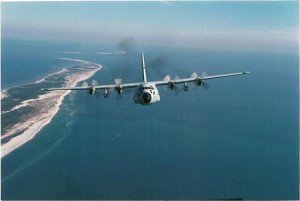The WC-130 aircraft looked frighteningly huge as it ascended over the waters of the Mississippi Sound. How could something that large, flying at what appeared to be such a gradual pace, make it off the Keesler Air Force Base runway and over the beach highway in Biloxi without falling out of the sky, I used to ask myself?

I never really thought that much about what the planes were doing or where they were going. Nor did the fact that I only saw these planes fly so languidly when I hung out on a hot summer day with my friends provide a clue as to the aircrafts’ missions.
It was an Air Force-looking plane and it took off from Keesler Air Force Base in Biloxi. I was a 19-year-old sailor stationed with the Seabees some 10 miles away in Gulfport. Since the planes were flying from an Air Force base, I figured they were up to Air Force things.
I knew, back then, that a lot of different activity went on at Keesler. I got my first pair of glasses — black, horn-rimmed ones which several later would look cool if you went for the Elvis Costello look — at Keesler because the dispensary at the Seabee base didn’t have an opthamologist or even an optometrist.
My homeboy, Jonathan, who lived with his first wife and then-baby girl over in Biloxi, attended air traffic control school at Keesler during a hitch in the Air Force. After I got back from Sea duty, one of my office subordinates on the ship transferred to Keesler to attend Chaplain’s Assistant school even though he was in the Navy.
But only years later would I figure out that those huge, slow planes that I saw at some time during summers on the Mississippi Gulf Coast beach were so important to my life when I decided to be a p’ert-near coast resident.
Those planes I saw, but didn’t know or particularly care what they were for back then, were Hurricane Hunters.
The 53rd Weather Reconnaissance Squadron at Keesler fly the WC-130s, or Lockheed Martin WC-130J Hercules if you want to get technically anal about it, into tropical systems to detect vital information which helps hurricane forecasters determine what a storm might do and where it might go. Often the Air Force Reserve crews manning the aircraft will fly right into the eye of a hurricane. You might think “calm” when talking about the eye until you remember you have the hurricane surrounding you.
This is one of those days, today, you might see one of these big slow planes take off and ever so slowly climb up into the sky over the Mississippi Sound and its barrier islands. A National Hurricane Center advisory around noon Central Daylight Time indicated an Air Force reconnaissance plane was approaching a low pressure center between Grand Cayman and Honduras. The NHC has given the system an 80 percent chance for tropical cyclone development.
Of course, the cable news media is all over the possibility of a storm like a gecko on an insurance commercial. That is because of the massive BP oil spill that continues to pour into the Gulf of Mexico and onto land from Louisiana to Florida.
My most not-favorite CNN anchor, Rick Sanchez, was making much ado about this not-even-tropical depression and the hurricane “models” which are already predicting paths for what could become the first named storm of the season. If it be comes a tropical storm it would be named Alex. The weather woman on CNN is at this moment as I write this saying which model would be “preferable” as for where the storm may go. She means what would be the best track for the storm, if there is a storm, as it might affect the oil spill and limit subsequent damage, if there is damage and if there is a storm. That is truly putting the dog before the pony show. The reason is that the models of where this storm might head currently extend from Tampico, Mexico, to Apalachicola, Florida. That’s a lot of ground, uh, water to cover and it includes the area in which I live.
In just the last five years I have been through three hurricanes, a tropical storm and four or five evacuations, if you count all those folks who came to this area from Hurricane Katrina until being chased away by Hurricane Rita. If I left out a storm, I apologize.
Don’t get me wrong. I am concerned about the BP gusher as I have been for awhile and not just for the oil-covered pelicans although I hate to see the environment f**ked up. But I am likewise concerned for my neighbors here on the Upper Texas Coast. That is why I am glad those building-sized, puzzling slow Air Force-looking planes I used to see when I was a young sailor are out there flying with confidence in the Gulf of Mexico hunting hurricanes. The information that those airmen out of Keesler gather is important to a lot of people and probably more folks than usual — because of the BP spill in the Gulf — await what comes from the storms that the Hurricane Hunters risk their lives to investigate.
Here is another look from AccuWeather about possible Alex paths.

Spelling error report
The following text will be sent to our editors: